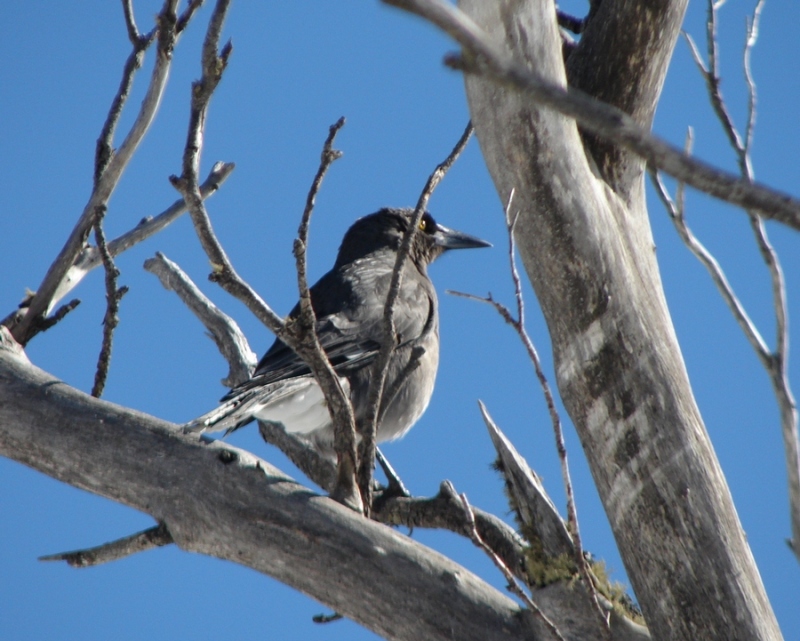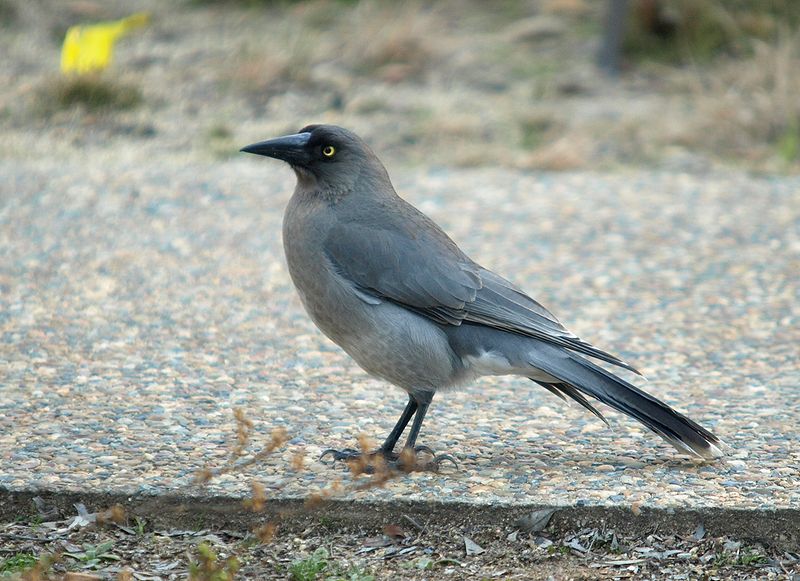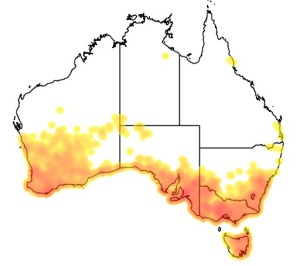
©Tatiana Gerus: Grey Currawong (Strepera (Strepera) versicolor) in Australian alpine forest, in Winter
Colours
Distinguishing features
The male is on average slightly larger than the female, but the size and weight ranges mostly overlap. It is generally a dark grey bird with white in the wing, undertail coverts, the base of the tail and most visibly, the tip of the tail. It has yellow eyes. The orbital (eye-ring), legs and feet are black, whereas the bill and gape range from greyish black to black. The overall plumage varies according to subspecies. The nominate race versicolor and plumbea are slate-grey in colour, while melanoptera and intermedia are blackish-brown, and arguta of Tasmania and halmaturina a sooty black. The size of the white patch on the wing also varies, being large and easily spotted in versicolor, plumbea, intermedia and arguta, but non-existent or indistinct in melanoptera and halmaturina. (Wikipedia)
Size
- From 44 cm to 57 cm (Length of specimen)
Wingspan
- From 72 cm to 85 cm
Synonyms
Distribution
Distribution and habitat preferences
They are found right across the southern part of Australia from the Central Coast region of New South Wales, occurring south of latitude 32°������S southwards and westwards, from the vicinity of Mudgee in the north and southwest to Temora and Albury onto the Riverina and across most of Victoria and southern South Australia to the fertile south-west corner of Western Australia and the semi-arid country surrounding it. The Clinking subspecies is endemic to Tasmania, where it is more common in the eastern parts, but is absent from King and Flinders Islands in Bass Strait. There is an outlying population in the arid area where the Northern Territory meets South Australia and Western Australia.
In general, it is sedentary throughout its range, although it appears to be resident in the cooler months only in south Gippsland in eastern Victoria and the far south coast of New South Wales.
It is found in wet and dry sclerophyll forests across its range, as well as mallee scrubland, and open areas such as parks or farmland near forested areas. It also inhabits pine plantations. Preferences vary between regions; subspecies versicolor is more common in wetter forests in southeastern mainland Australia, while the Tasmanian subspecies arguta is found most commonly in lowland dry sclerophyll forest. The subspecies melanoptera and intermedia are found mainly in mallee scrublands and woodlands, while in Western Australia, subspecies plumbea is found in various forests and woodlands, such as Jarrah (Eucalyptus marginata), Karri (E. diversicolor), Tuart (E. gomphocephala) and Wandoo (E. wandoo), as well as paperbark woodlands around swampy areas, and acacia shrublands dominated by summer-scented wattle (Acacia rostellifera) and mulga (Acacia aneura) with Eremophila understory. (Wikipedia)
Diet
It is an omnivorous and opportunistic feeder. It preys on many invertebrates, such as snails, spiders and woodlice, and a wide variety of insects including beetles, earwigs, cockroaches, wasps, ants and grasshoppers, and smaller vertebrates, including frogs, lizards such as the Bearded Dragon as well as skinks, rats, mice, and nestlings or young of Tasmanian Native-hen, Red Wattlebird, Eastern Spinebill, House Sparrow (Passer domesticus), and Splendid Fairywren (M. splendens).
It has been recorded hunting at the nests of the Superb Fairywren (Malurus cyaneus), and the Bell Miner (Manorina melanophrys).
A wide variety of plant material is also consumed. (Wikipedia)

